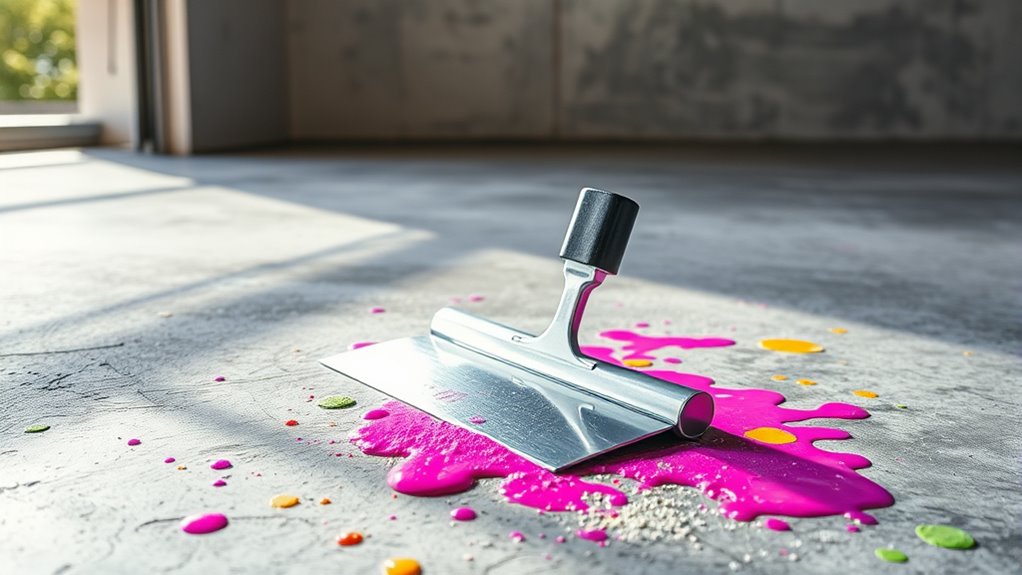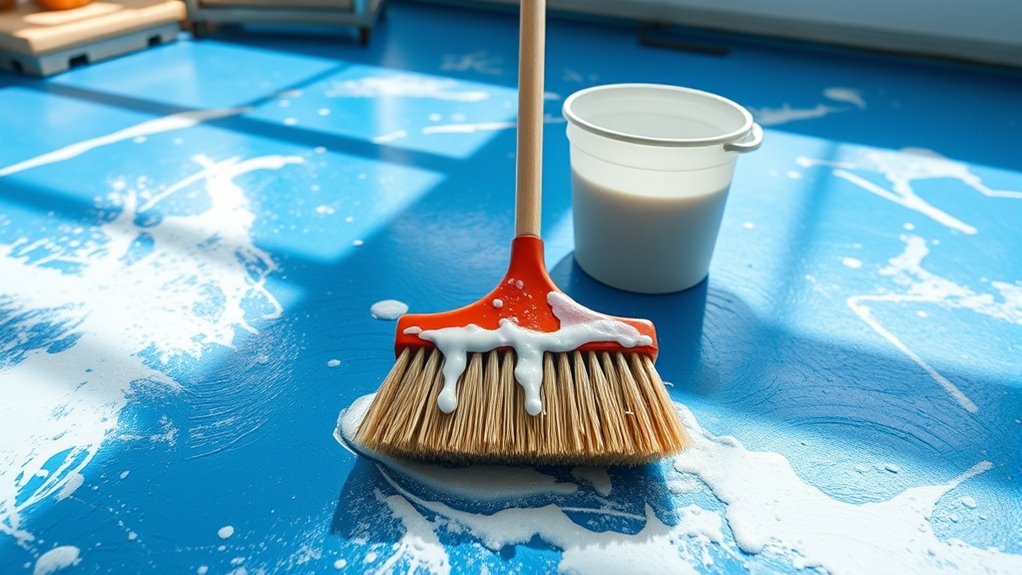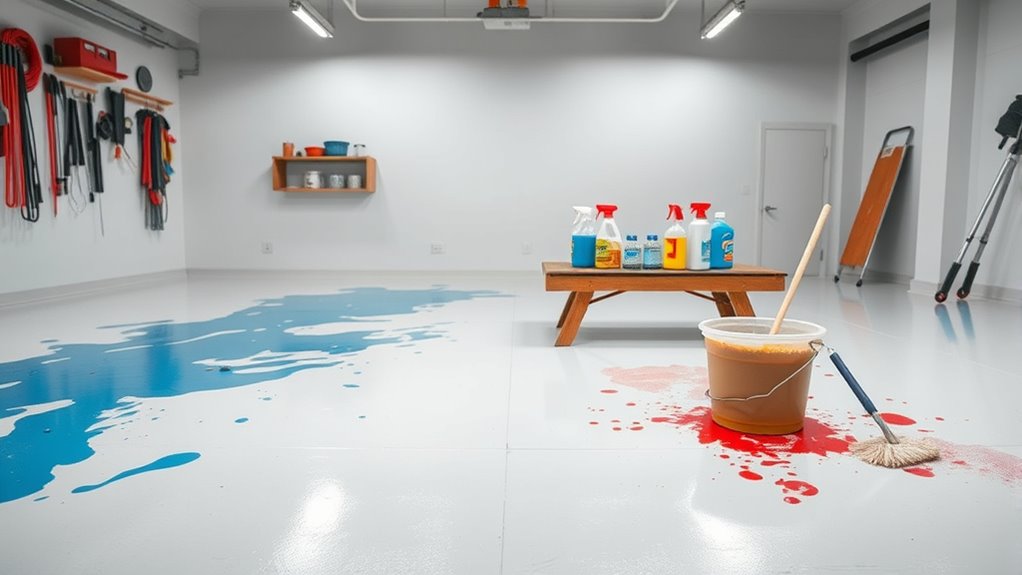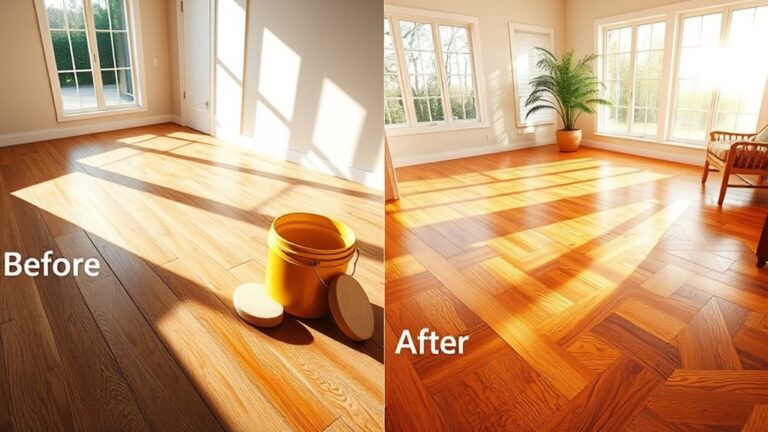To remove paint from your garage floor, start by gathering gloves, scrapers, brushes, paint stripper, and a pressure washer. Clear and sweep the area, then scrape off thick paint layers carefully. Apply a paint remover suited for concrete and let it sit as directed. Scrub the softened paint with a stiff brush, rinse thoroughly using a hose or pressure washer, and apply degreaser if needed. Let the floor dry completely, and you’ll be set for the next steps to restore your space effectively.
Gather Necessary Tools and Materials

Before you begin removing paint from your garage floor, you’ll need to gather the right tools and materials to make the job efficient and safe. Start with choosing suitable paint removal methods—chemical paint strippers, a wire brush, or a power washer are common options. Each method requires specific tools, so pick what fits your situation best. Next, assemble essential cleaning supplies: heavy-duty gloves to protect your hands, safety goggles for your eyes, a respirator mask if you’re using strong chemicals, and sturdy scrubbing brushes. Have a bucket, rags, and a scraper ready to help remove loosened paint. Preparing these tools beforehand not only speeds up the process but also guarantees you maintain control and safety as you reclaim your garage floor’s freedom.
Prepare the Garage Floor for Cleaning
While gathering your tools is essential, preparing the garage floor properly guarantees the paint removal process goes smoothly. Start by clearing the area completely—move vehicles, tools, and anything that could get in the way. Sweep the floor thoroughly to remove dust and debris, ensuring your cleaning supplies work effectively. Next, inspect the floor for grease or oil stains; these can interfere with paint removal, so treat them with a degreaser before proceeding.
| Step | Description |
|---|---|
| Clear the space | Remove all items from the floor |
| Sweep thoroughly | Eliminate dust and dirt |
| Inspect stains | Identify grease or oil spots |
| Pre-treat stains | Use degreaser on problem areas |
This floor preparation sets you free to tackle paint removal without unnecessary obstacles.
Scrape Off Excess Paint

You’ll want to use a sturdy paint scraper or putty knife to carefully remove the thickest layers of paint from your garage floor. Make sure to wear gloves and safety goggles to protect your hands and eyes from sharp edges and paint chips. Taking these precautions will help you scrape effectively without injury or damage.
Tools for Effective Scraping
Several essential tools can make scraping off excess garage floor paint more efficient and less labor-intensive. When focusing on scraping techniques, choosing the right tools is critical. A sturdy paint scraper or putty knife with a sharp, angled blade works well for lifting thick paint layers without damaging the concrete. For larger areas, consider a floor scraper with a long handle to maintain comfort and control. Wire brushes or abrasive pads help remove stubborn paint residues after initial scraping. Your tool selection should balance durability and ease of use, allowing you to work freely and confidently. By investing in quality, purpose-built tools, you’ll speed up the removal process and achieve cleaner results with less effort.
Safety Precautions During Scraping
Because scraping garage floor paint involves sharp tools and potential exposure to dust and chemicals, taking proper safety precautions is vital. Always prioritize gloves usage to protect your hands from cuts and chemical irritation. Choose sturdy, well-fitting gloves designed for heavy-duty work. Ventilation importance can’t be overstated—make sure your garage doors and windows are open, and consider using fans to circulate fresh air. This helps reduce inhaling harmful dust and fumes that scraping stirs up. Wear safety goggles to shield your eyes from flying debris. Also, dress in long sleeves and pants to minimize skin exposure. Taking these steps guarantees you work safely and maintain the freedom to tackle your project without unnecessary health risks or injuries. Safety is your key to success during paint removal.
Apply a Paint Remover or Stripper
You’ll want to pick a paint remover designed specifically for concrete to avoid damage and get the best results. Make sure you wear gloves and a mask to protect yourself from harsh chemicals during application. Applying the stripper evenly with a brush or roller helps it work effectively, so take your time with this step.
Choosing the Right Product
Anyone tackling garage floor paint removal needs to pick the right product carefully, as not all paint removers work the same on concrete surfaces. You’ll find various paint remover types, including chemical strippers, gel-based removers, and eco-friendly options. Chemical strippers tend to be highly effective but may require extra ventilation, while gel formulas cling better to vertical or uneven surfaces, enhancing product effectiveness. Eco-friendly removers offer a safer alternative but might need more time to work. Assess the paint type on your garage floor and check product labels for compatibility with concrete. Choosing a remover designed specifically for your paint and surface guarantees faster results and less effort, giving you the freedom to restore your garage floor smoothly and efficiently.
Safety Precautions Needed
After selecting the right paint remover for your garage floor, the next step is to prioritize safety throughout the application process. First, always wear personal protective equipment like gloves, goggles, and a respirator to protect your skin, eyes, and lungs from harmful chemicals. Make sure to dress in long sleeves and pants to minimize skin exposure. Next, focus on ventilation considerations—open windows and doors, and use fans to keep fresh air flowing and reduce inhalation risks. Avoid working in confined spaces where fumes can accumulate. Keep a fire extinguisher nearby, especially if the remover is flammable. Finally, read the product’s safety instructions thoroughly before starting. Taking these precautions will help you maintain your freedom to work safely and efficiently while removing paint.
Application Techniques Explained
Before applying the paint remover, make certain the garage floor is clean and dry to guarantee maximum effectiveness. Choose the right application method based on your paint remover type—gel, liquid, or paste. For gels and pastes, use a brush or roller to spread a thick, even layer. Liquids may require spraying for broader coverage. Apply liberally, ensuring full contact with the painted surface. Follow the manufacturer’s recommended dwell time closely to allow the remover to penetrate the paint layers. Avoid rushing this step, as proper dwell time is essential for effective paint removal. Once the paint softens, use a scraper or stiff brush to lift the residue. Rinse the floor with water or a neutralizing solution if instructed. Mastering these application methods frees you to restore your garage floor efficiently.
Let the Paint Remover Sit
While the paint remover starts working, you’ll want to give it enough time to penetrate the paint thoroughly. This waiting period is essential for maximizing paint remover effectiveness. Keep in mind, the paint drying time before removal impacts how long you should let the remover sit. Here’s how to handle this step efficiently:
- Check the product label for recommended wait times.
- Avoid rushing; letting it sit too briefly reduces effectiveness.
- For thicker or multiple paint layers, extend the wait time slightly.
- Protect the area from dust or debris while the remover works.
- Guarantee good ventilation to safely speed up chemical action.
Scrub the Paint Stains

You’ll want to pick a stiff-bristled brush to tackle the paint stains without damaging the concrete. Use firm, circular motions to break up the softened paint, focusing on stubborn spots. Applying consistent pressure while scrubbing helps lift the paint effectively.
Choosing the Right Brush
Selecting the right brush is essential for effectively scrubbing paint stains off your garage floor without damaging the surface. You’ll want to reflect on different brush types and bristle materials to match the job. Here’s what to keep in mind:
- Stiff nylon bristles: Great for tough paint but gentle enough for concrete.
- Natural fiber bristles: Work well on delicate surfaces but might wear out quickly.
- Wire brushes: Ideal for heavy-duty scraping but use cautiously to avoid surface scratches.
- Scrub brushes with ergonomic handles: Help reduce hand fatigue during extended scrubbing.
- Size and shape: Choose a brush that fits the stain area for precise control.
Picking the right brush guarantees you preserve your garage floor’s finish while freeing it from paint stains effectively.
Effective Scrubbing Techniques
Start by applying firm, consistent pressure as you scrub the paint stains, working in circular motions to break up and lift the paint from the concrete surface. Use effective materials like stiff nylon brushes or scrubbing pads designed for rough surfaces. Avoid wire brushes unless the paint is extremely stubborn, as they can damage the concrete. Dip your brush in a suitable paint remover or soapy water to help dissolve the paint more efficiently. Focus on small sections, scrubbing thoroughly to prevent spreading the stain. Rinse frequently to check your progress and avoid residue buildup. Remember, consistent scrubbing techniques combined with the right materials will save you time and effort, giving you the freedom to restore your garage floor quickly and effectively.
Rinse the Floor Thoroughly
Although rinsing the floor might seem straightforward, doing it thoroughly is vital to remove all paint residues and cleaning agents. Proper rinsing prevents slipperiness and prepares your garage floor for future use, contributing to effective floor maintenance. To rinse effectively, make sure you:
- Use a garden hose with a strong, steady stream.
- Start rinsing from the farthest corner, moving toward the exit.
- Pay close attention to corners and crevices where cleaning solutions might linger.
- Repeat rinsing until the water runs clear and free of suds.
- Use a mop or squeegee to push excess water toward a drain or outside.
Doing this guarantees your garage floor is free from harmful residues, keeping your space safe and ready for your next project.
Use a Pressure Washer for Stubborn Spots
When paint stains won’t come off with regular rinsing, using a pressure washer can make all the difference. Start by selecting the right nozzle—usually a 25-degree tip works best for stubborn paint removal without damaging your garage floor. Hold the wand about 12 inches from the surface, moving it steadily to avoid etching. Use pressure washer techniques like overlapping strokes to guarantee even cleaning and avoid missing spots. Test a small area first to confirm the pressure won’t harm the concrete. For deeply embedded paint, multiple passes may be necessary. Remember to wear protective gear and work in a well-ventilated area. This method saves time and effort, giving you the freedom to enjoy a clean, paint-free garage floor quicker and more efficiently.
Apply a Degreaser for Remaining Residue
If you still notice grease or oily residue after pressure washing, applying a degreaser is the next vital step. Choosing the right degreaser type is important for effective residue removal without damaging your garage floor. Here’s how to proceed:
- Select a degreaser suitable for concrete surfaces; citrus-based or enzymatic types are eco-friendly options.
- Apply the degreaser generously to affected areas, targeting stubborn grease or paint remnants.
- Allow it to sit for 10-15 minutes to break down oils and residues.
- Scrub the surface with a stiff brush to loosen dirt and paint particles.
- Rinse thoroughly with water to wash away the degreaser and lifted residue.
Following these steps guarantees your floor is clean and prepped for any further treatment or repainting.
Allow the Floor to Dry Completely
Allowing your garage floor to dry completely is an essential step before moving on to any further treatment or painting. Proper drying time confirms the surface is ready, preventing future peeling or uneven finish. To speed up drying, maintain proper ventilation by opening windows and doors or using fans.
| Step | Action | Tip |
|---|---|---|
| 1 | Wipe excess moisture | Use absorbent towels |
| 2 | Confirm air circulation | Position fans strategically |
| 3 | Check dryness level | Test with your hand or paper |
Taking these steps assures your garage floor is fully dry, giving you the freedom to proceed with confidence and achieve a smooth, lasting result.




